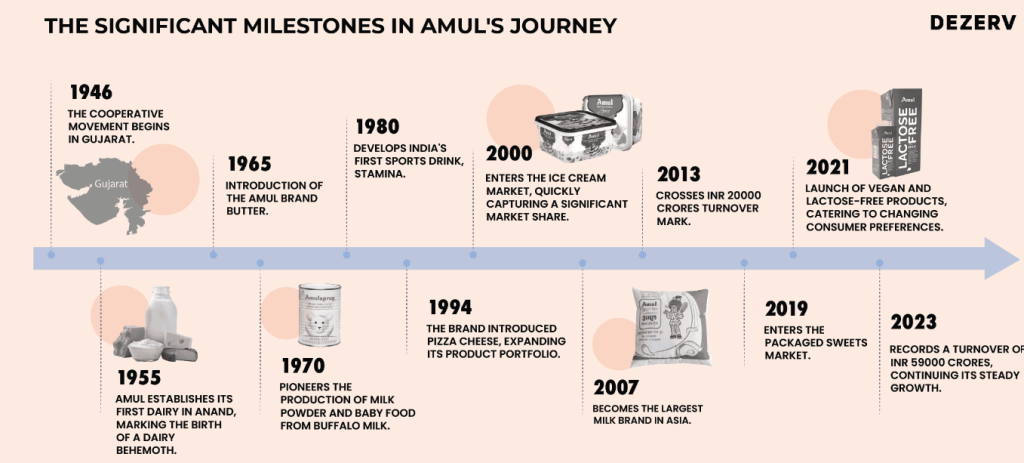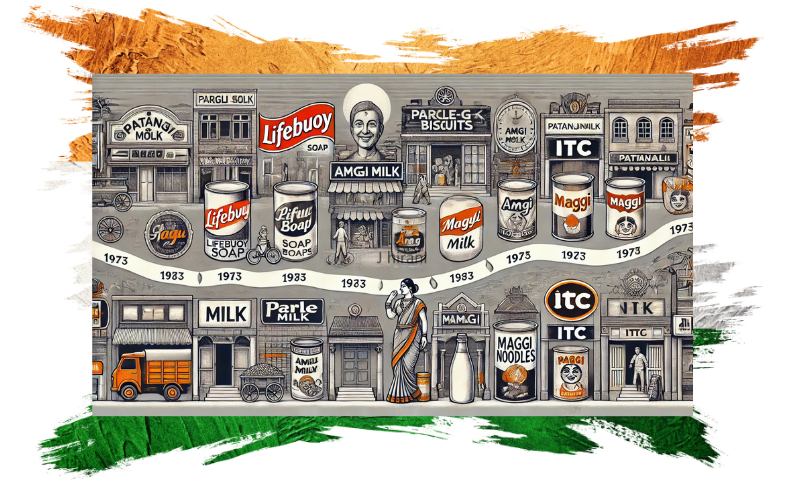Welcome to the bustling world of FMCG, where every trip to the local Kirana store or supermarket is an adventure waiting to unfold. Everyone knows about the large FMCG brands and their presence and how we get everything at a blink – let’s understand the evolution of Indian FMCG brands -from ‘birth to boom’. This blog is first in the series of FMCG industry exploration, digging information of the industry’s evolution and growth. Find next blog link at the end of page.
In this we’re going to take a closer look at the fascinating world of Fast-Moving Consumer Goods (FMCG).
The story begins in the early 20th century when the FMCG sector was taking its baby steps in India.
One of the first brands to emerge was Hindustan Unilever Limited (HUL), formerly known as Lever Brothers, which introduced its iconic product, Sunlight Soap, to the Indian market in 1888. This marked the beginning of a revolution in consumer goods, as HUL expanded its product range to include household names like Lux, Lifebuoy, and Rin. HUL’s growth in India can be attributed to its relentless focus on innovation, quality, and consumer-centricity. The company invested heavily in research and development to develop products tailored to the Indian market, considering factors like cultural preferences and affordability. HUL also adopted a multi-brand strategy, launching sub-brands within its product categories to cater to different consumer segments. It leveraged its extensive distribution network to penetrate deep into rural and urban markets across India. The company’s vast distribution network, comprising wholesalers, retailers, and distributors, ensured that its products were readily available to consumers even in remote areas. HUL’s strong brand equity and aggressive marketing campaigns further solidified its position as a market leader in India.

As India gained independence and embarked on a journey of economic development, the FMCG sector experienced exponential growth. With the liberalization of the economy in 1991, multinational corporations entered the Indian market, bringing with them a slew of international brands and modern retail formats.
This period witnessed the rise of household names like Colgate-Palmolive, Nestlé, Dabur, Amul, Godrej and Procter & Gamble, which became synonymous with quality and reliability.
Nestlé
A Swiss multinational entered the Indian market in 1912 with the establishment of Nestlé India Limited. The company initially focused on importing and selling infant food products, such as Cereal. Over the years, Nestlé diversified its product portfolio to include a wide range of food and beverage products, including Maggi noodles, Nescafé coffee, and KitKat chocolates. Nestlé’s growth in India can be attributed to its strategic acquisitions, product innovations, and strong brand presence. The company acquired iconic Indian brands like Maggi and Munch, leveraging their popularity to expand its market share. The company also invested in research and development to develop products tailored to local tastes and preferences, such as spicy variants of Maggi noodles. It focused on building strong brand equity through effective marketing and advertising campaigns.

Amul
An acronym for Anand Milk Union Limited, is one of India’s most iconic and successful dairy cooperatives. Founded in 1946 by Dr. Verghese Kurien and Tribhuvandas Patel in Gujarat, Amul began as a cooperative movement aimed at empowering local dairy farmers and ensuring fair prices for their milk. Over the years, Amul has grown into a multifaceted FMCG brand, offering a wide range of dairy products, including milk, butter, cheese, ice cream, and more. Amul’s growth is deeply rooted in its cooperative model, which involves empowering dairy farmers and providing them with a platform to collectively market their produce. The cooperative structure ensures that farmers receive a fair share of the profits, fostering a sense of ownership and commitment among stakeholders. Amul has successfully expanded its footprint in urban markets, leveraging its strong brand equity and diverse product portfolio. The company’s innovative marketing campaigns and strategic partnerships with retailers have helped it capture a significant share of the urban consumer market.

The FMCG sector in India was characterized by intense competition, with players vying for market share through aggressive marketing strategies and product innovations. Traditional distribution channels like Kirana stores coexisted with modern retail chains, offering consumers a wide range of choices. Despite occasional challenges like supply chain disruptions and regulatory hurdles, the FMCG sector continued to thrive, fueled by rising disposable incomes and changing consumer preferences.
The packaging, marketing, and positioning of these products also play crucial roles, which we will delve into further in our upcoming blog.
As the world slowly emerged from the grips of the pandemic, the FMCG sector in India demonstrated remarkable resilience. Companies accelerated their digital transformation efforts, embracing technology to streamline operations and enhance the online shopping experience. Health and wellness emerged as top priorities for consumers, leading to increased demand for immunity-boosting products and organic alternatives. FMCG companies responded by diversifying their product portfolios and investing in research and development to cater to evolving consumer preferences. However, product innovation alone is not sufficient. The packaging, marketing, and positioning of these products also play crucial roles, which we will delve into further in our upcoming blog.
Read Next Blog in FMCG Series here Standouts in Packaging: Indian FMCG Brands Art of Standing Out » J.hirani
GET THIS IN YOUR INBOX
J.hirani provides strategic advisory services to manufacturing, service brands, product brands, online/ offline business. Read our capabilities.



